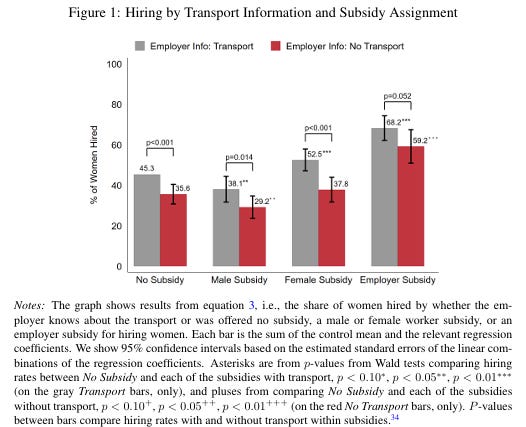Paternalistic Discrimination
Paternalistic Discrimination
Authors: Nina Buchmann, Carl Meyer, Colin D Sullivan
Abstract: Women in South Asia struggle to access the labor market, especially in male-dominated occupations, despite recent progress in education and training. We conduct a two-sided field experiment in Dhaka, Bangladesh, to identify a novel form of discrimination, which we term paternalistic discrimination: the preferential treatment of male workers to protect female workers from tasks or jobs perceived as difficult or harmful. We observe real hiring and application decisions for a night-shift job that provides safe worker transport home at the end of the shift. We experimentally vary the perceived welfare of the workers by varying whether we inform employers about this amenity before they make their hiring decisions or whether we inform applicants about this amenity before they make their application decisions. Not informing employers decreases the demand for female labor by 25%---suggesting that employers discriminate paternalistically---while not informing applicants decreases the female labor supply by 16%. Combining the results of the two experiments in an equilibrium model, we demonstrate that eliminating paternalistic discrimination would reduce the experiments' gender employment and wage gaps. Finally, our counterfactual exercises suggest that providing safe transport is a cost-effective way to increase employer profits and worker welfare in our setting.
Seminar Notes
Objective
To understand if employers exhibit paternalistic discrimination towards women applicants using a field experiment in Bangladesh
Background
Literature defines two types of discrimination: taste-based versus statistical.
Paternalistic discrimination - Preferential treatment of men to protect women
Methodology
Theory - employer decision problem includes what they think the applicants' utility from the job would be "other-regarding utility"
Field experiment - Night-shift job in Bangladesh with transport. Vary whether employers are told about the transport. Applicants don't know about transport. Only 1 shift.
Results
Employers who know about transport choose 45% women applicants. Those that do not only choose 35%
No transport reduces female labor by 19% and wages by 24%



